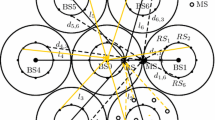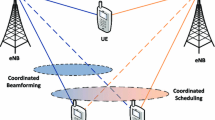Abstract
In 4G cellular networks: LTE/LTE-Advanced and the mobile WiMAX network, some key impact factors: white Gaussian noise, wireless interference, shadow fading, etc., degrade signal transmission quality and reduce wireless service coverage significantly. The degradations can be improved by deploying more eNBs or BSs, but the expensive eNB/BS extremely increases network cost. The specifications of LTE-Advanced and IEEE 802.16j thus propose a relay-based scheme, namely mobile multihop relay (MMR) networks, to cooperate with the existing cellular network while not obviously increasing the relay station (RS) deployment cost. Various types of RSs: Fixed RS, Nomadic RS and Mobile RS, can be adopted in MMR networks. To efficiently deploy different types of RSs becomes a critical issue. Thus, this paper first analyzes the impact factors: transmission quality, deployment price, service coverage and RS overlap index, and then models the cost-effective issue of the RS deployment as an optimization problem. The paper proposes an adaptive cost-based RS deployment (ACRD) approach to form a cost function in terms of all impact factors, and then solves the optimization problem by determining the RS deployment with the least network cost as the solution. Numerical results demonstrate that ACRD outperforms the compared approaches in network cost, transmission quality, RS deployment price, service coverage, and RS overlap index. Additionally, ACRD deploys more RSs on the areas with high-density populations and thus increases transmission quality and guarantees the quality of service (QoS). Finally, the worst case running time of ACRD is analyzed, which requires \( T(n) = O(I \cdot P) \).













Similar content being viewed by others
References
3GPP TR 36.201 V8.2.0. (2008). LTE physical layer—General description. 3GPP Rel. 8.
(2006). IEEE standard for local and metropolitan area networks part 16: Air interface for fixed and mobile broadband wireless access systems amendment 2: Physical and medium access control layers for combined fixed and mobile operation in licensed bands and corrigendum 1. IEEE Std. 802.16e-2005 and IEEE Std 802.16-2004/Cor 1-2005, pp. 0_1-822.
(2009). IEEE 802.16j: Baseline document for draft standard for local and metropolitan area networks part 16: Air interface for fixed and mobile broadband wireless access systems.
3GPP TR 36.912 V10.0.0. (2011). Feasibility study for further advancements for E-UTRA (LTE-Advanced). 3GPP, pp. 6–61.
Yang, Y., Hu, H., Xu, J., & Mao, G. (2009). Relay technologies for WiMAX and LTE-Advanced mobile systems. IEEE Communications Magazine, 47(10), 100–105.
Fu, I.-K., Sheen, W.-H., & Ren, F.-C. (2007). Deployment and radio resource reuse in IEEE 802.16j multi-hop relay network in Manhattan-like environment. International conference on information, communications and signal processing, pp. 1–5.
Yu, Y., Murphy, S., & Murphy, L. (2008). Planning base station and relay station locations in IEEE 802.16j multi-hop relay networks. In Consumer communications and networking conference, pp. 922–926.
Kim, S.-J., Kim, S.-Y., Lee, B.-B. Ryu, S.-W., Lee, H.-W., & Cho, C.-H. (2008). Multi-hop relay based coverage extension in the IEEE802.16j based mobile WiMAX systems. In Fourth international conference on networked computing and advanced information management, Vol. 1, pp. 516–522.
Ge, Y., Wen, S., & Ang, Y.-H. (2009). Analysis of optimal relay selection in IEEE 802.16 multihop relay networks. In IEEE wireless communications and networking conference, pp. 1–6.
Lin, B., Ho, P., Xie, L., & Shen, X. (2007). Optimal relay station placement in IEEE 802.16j networks. In International conference on wireless communications and mobile computing, pp. 25–30.
Theodoros, T., & Kostantinos, V. (2007). WiMax network planning and systemys performance evaluation. In IEEE wireless communications and networking conference, pp. 1948–1953.
Grenier, E., & Humire, D. (2006). Mesh network planning in urban environment. In ATDI, pp. 1–35.
Schoenen, R., & Otyakmaz, A. (2010). QoS and flow management for future multi-hop mobile radio networks. In IEEE VTC2010-Fall, pp. 1–5.
Loa, K., Wu, C.-C., Sheu, S.-T., Yuan, Y., Chion, M., Huo, D., & Ling, X. (2010). IMT-advanced relay standards. IEEE Communications Magazine, 48(8), 40–48.
Wang, Y., Feng, G., & Zhang, Y. (2011). Cost-efficient deployment of relays for LTE-Advanced cellular networks. In IEEE ICC 2011, pp. 1–6.
Beniero, T., Redana, S., Hämäläinen, J., & Raaf, B. (2009). Effect of relaying on coverage in 3GPP LTE-Advanced. In IEEE VTC-Spring 2009, pp. 1–5.
Saleh, A. B., Bulakci, Ö., Redana, S., Raaf, B., & Hämäläinen, J. (2010). Enhancing LTE-advanced relay deployments via biasing in cell selection and handover decision. In IEEE PIMRC 2010 (pp. 2277–2281). Istanbul, Turkey.
Peters, S. W., & Heath, R. W. (2009). The future of WiMAX: Multihop relaying with IEEE 802.16j. IEEE Communications Magazine, 47(1), 104–111.
Genc, V., Murphy, S., Yu, Y., & Murphy, J. (2008). IEEE 802.16 J relay-based wireless access networks: an overview. IEEE Wireless Communications, 15(5), 56–63.
Kwok, Y.-K. R., & Lau, V. K. N. (2007). Wireless internet and mobile computing: Interoperability and performance. Hoboken: Wiley-IEEE Press.
Shin, J. S., Kumar, R., Shin, Y. S., & La Porta, T. F. (2008). Multi-hop wireless relay networks of mesh clients. In IEEE wireless communications and networking conference, pp. 2717–2722.
Masato, O., Zhu, C. X., & Dorin, V. (2008). Multihop relay extension for WiMAX networks: Overview and benefits of IEEE 802.16j standard. Fujitsu Scientific and Technical Journal, 44(3), 292–302.
Acknowledgments
This research was supported in part by the National Science Council of Taiwan, ROC, under Grants NSC-101-2221-E-224-022-MY3 and NSC-103-2221-E-252-008.
Author information
Authors and Affiliations
Corresponding author
Rights and permissions
About this article
Cite this article
Chang, BJ., Liang, YH. & Su, SS. Analyses of Relay Nodes Deployment in 4G Wireless Mobile Multihop Relay Networks. Wireless Pers Commun 83, 1159–1181 (2015). https://doi.org/10.1007/s11277-015-2443-x
Published:
Issue Date:
DOI: https://doi.org/10.1007/s11277-015-2443-x




